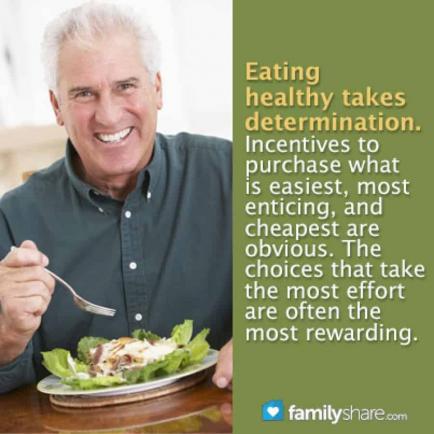
How does a person eat healthy in a world where genetically modified and artificial fillers are included in food that line the grocery store shelves? Here are just a few tips on how to navigate the modern food economy:
1. Shop at stores that offer local product
We are accustomed to getting what we want, when we want it. Apples, watermelons, and peaches in December on the North American continent are fine, but the choice to purchase them out of season must be weighed against what it takes to get them at odd times of the year. Often, the product must be modified or picked early for it to survive the trip halfway around the world. This may reduce nutritional content. Also, pesticides banned due to health risks are often used in other countries, where they may not have the same requirements. This may also apply to the way livestock is treated.
2. Buying local does not guarantee a quality product
In these instances, buying organic is a way to guarantee a product is both healthy and safe. It is true that organic food can be expensive. However, organic product can be found on sale, just like other products. If you shop around, it is possible to eat organic on a budget.
3. One way to eat organic is to grow your own garden
It guarantees that what you see is what you get, but gardening does take some effort. Fruits and vegetables are mostly annuals and must be planted every year. However, there are many that are perennials: consider strawberries, raspberries, and blueberries. Also, consider planting fruit trees instead of ornamental or shade trees since they will produce every year the weather permits them to flower. Gardening is well worth the effort. Beware: you will be forever spoiled. Once you've tasted fruits and vegetables from your own garden, you will never like the taste of produce from the store, again. You will wonder what exactly it is they are selling you.
4. Avoid prepared foods
They are loaded with fat, sugar, and salt. Take the time to read the contents and nutritional information. Your head will spin. Watch for products that claim to be healthy. Don't rely on their claims. Read the label to be sure.
5. Eat at home
Like prepared foods, meals served at restaurants are loaded with stuff that is bad for you. A restaurant's aim is to serve you something that tastes great. Restaurants that claim they have healthy food add sauces and other niceties that suddenly make a healthy meal into something that is not.
6. Last, always examine ingredients, weights, and price per unit
Examining ingredients ensures you know what you are buying. If the ingredients list extends the length of the packaging and you have no idea what most of them are, they are probably not good for you. Do not assume that the larger package contains more product. Look at the weight and price per unit. This especially applies to products you have been buying regularly and have not checked for a while. Something may no longer be a gallon or half gallon. A box that once contained enough product to provide a side dish for a family of four, may now be about twenty percent full and barely offers one serving.
Eating healthy takes determination. Incentives to purchase what is easiest, most enticing, and cheapest are obvious. The choices that take the most effort are often the most rewarding.

